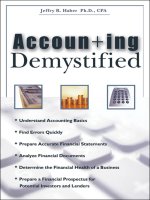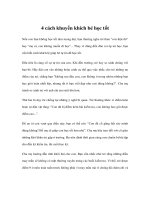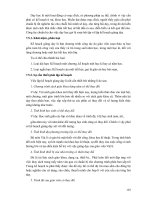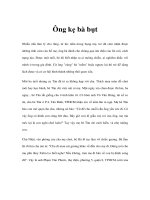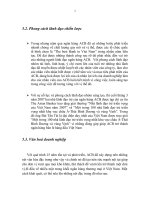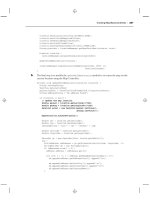Accounting Demystified phần 7 pps
Bạn đang xem bản rút gọn của tài liệu. Xem và tải ngay bản đầy đủ của tài liệu tại đây (204.51 KB, 19 trang )
102
Accounting Demystified
need to deliver stock to fulfill the company’s obligation to a
stock option or bonus plan. In any event, the stock re-
purchased by the company is called treasury stock. If there is a
difference between the number of shares issued and the num-
ber of shares outstanding, it is because of treasury stock. Once
the stock has been issued to the public, it is counted as issued,
but if it is repurchased by the company and held as treasury
stock, it is not included in the total of the stock outstanding. If
a company has no treasury stock, then the figures for the is-
sued and outstanding shares will be the same.
The following example will illustrate:
Example A
Number of shares authorized: 1,000,000 shares
Number of shares issued 500,000 shares
Number of treasury shares 0 shares
Therefore, the number of shares outstanding is 500,000
shares (500,000 shares issued – 0 shares in treasury).
Example B
Number of shares authorized 1,000,000 shares
Number of shares issued 500,000 shares
Number of treasury shares 200,000 shares
Therefore, the number of shares outstanding is 300,000
shares (500,000 shares issued מ 200,000 shares in treasury).
Recording the Issuance
No matter whether the stock is par value, no par value but
stated value, or no par value, the debit part of the transaction
10288$ CH16 08-29-03 08:31:36 PS
103
Stockholders’ Equity
is always what the company receives. Usually this is cash. The
credit side depends on the type of stock: whether it is par
value, no par value but stated value, or no par value. If there is
a par value or a stated value, there will be a credit to an ac-
count called Common stock for the number of shares issued
multiplied by the par or stated value. If this is less than the
amount received, there will be another credit to an account
called Additional paid-in capital or sometimes Paid-in capital
in excess of par.
So let us assume that a company has stock with a par value
of $0.01. The company sells 100,000 shares on February 22,
2002, for a total price of $500,000. The entry would be:
2/22/02 Cash 500,000 (A)
Common stock 1,000 (B)
Additional paid-in capital 499,000 (C)
To record issuance of stock
(A)
is the amount received
(B)
is 100,000 times $0.01
(C)
is the amount needed to balance the journal entry
If the stock issued were no par value, the entry would be:
2/22/02 Cash 500,000
Common stock 500,000
To record issuance of stock
Treasury Stock
When a company buys its own stock in the open market, the
entry is fairly straightforward. The company records the
10288$ CH16 08-29-03 08:31:37 PS
104
Accounting Demystified
amount paid as a debit to Treasury stock (which is a reduction
in the stockholders’ equity section) and a credit to Cash for the
amount paid for the stock.
Let’s assume that on December 11, 2002, a company re-
purchases 1,000 shares of its stock in the open market at a
price of $4.00 per share. The entry to record the repurchase is:
12/11/02 Treasury stock 4,000
Cash 4,000
To record purchase of treasury stock
The stockholders’ equity section of the balance sheet will
appear as follows:
Stockholders’ equity
Common stock (1,000,000 shares authorized, 500,000
issued, and 499,000 outstanding; par value of $0.01) $ 5,000
Additional paid-in capital 495,000
Subtotal 500,000
Less: Treasury stock 4,000
Total contributed capital 496,000
Retained earnings 250,000
Total stockholders’ equity $746,000
Dividends
A company will generally issue dividends in the form of cash.
Sometimes it will issue additional shares of its stock as a divi-
dend (called a stock dividend) when it wants to issue a divi-
dend but does not have the cash available for a cash dividend.
Only the board of directors of a company may declare a divi-
10288$ CH16 08-29-03 08:31:37 PS
105
Stockholders’ Equity
dend. Once a dividend is declared, it cannot be rescinded. The
declaration of a dividend by the board of directors legally
binds a company to pay that dividend.
There are many dates associated with the dividend. The
date on which the dividend is declared by the board of direc-
tors is called the declaration date. On the declaration date, the
company will make a journal entry to record the declaration of
the dividend. It does this by debiting the Dividends account
and recording a liability to pay the dividend. If there were
1,000,000 shares outstanding on December 18, 2002, and the
board of directors declared a $1.00 dividend, the entry would
be:
12/18/02 Dividends 1,000,000
Dividends payable 1,000,000
To record the declaration of a dividend
(1,000,000 shares outstanding ן $1.00 per
share)
When the company declares the dividend, it will indicate a
record date. Whoever owns the shares at the close of business
on the record date will be entitled to the dividend. The record
date enables the company to determine which shareholders
get the dividend. Since the stock may be traded constantly,
specifying the record date allows the public to know who will
get the dividend. There is no journal entry needed on the re-
cord date.
The payment date is the date on which the company will
send out the checks. Using the figures from the previous exam-
ple, if the payment date is December 30, 2002, the entry will
be:
10288$ CH16 08-29-03 08:31:38 PS
106
Accounting Demystified
12/30/02 Dividends payable 1,000,000
Cash 1,000,000
To record the payment of dividends
No dividends are paid on treasury shares. If a company has
treasury stock, these shares do not receive the dividend. If a
company has 1,000,000 shares authorized, 500,000 issued, and
499,000 shares outstanding, then the declaration of a $1.00 per
share dividend on December 19, 2002, would result in the fol-
lowing entry:
12/19/02 Dividends 499,000
Dividends payable 499,000
To record declaration of dividends (499,000
shares outstanding ן $1.00 per share)
10288$ CH16 08-29-03 08:31:38 PS
CHAPTER
17
Merchandising
Companies
The examples we have used so far have not discussed some
characteristics that are specific to merchandising companies.
Service companies offer a service to the public, such as ac-
counting, bookkeeping, legal, architecture, billing, or consult-
ing services. They derive their revenue by providing these
services, with the sale of any merchandise being incidental to
their operations. In contrast, merchandising companies get
their revenue from the sale of merchandise or goods. They may
get some revenue from the sale of services, but this is inciden-
tal to their operations.
The differences between service companies and merchan-
dising companies are reflected in the financial statements. On
the Balance Sheet, there is a minor difference: The merchan-
dising company has inventory, and the service company does
107
10288$ CH17 08-29-03 08:31:36 PS
108
Accounting Demystified
not. The bigger difference is on the Income Statement. The
basic Income Statement used by service companies (also called
the single-step Income Statement) is shown in Figure 17-1.
This type of Income Statement is called a single-step in-
come statement because there is only one subtraction neces-
sary to arrive at net income. Merchandising companies add at
least one more step to the Income Statement. Since merchan-
dising companies earn their revenue from the sale of products,
the Income Statement needs to reflect both the money re-
ceived from the sale of the goods and the cost of the goods that
were sold. This interim step adds a subtotal called gross profit.
Gross profit is the difference between revenue and the cost of
goods sold (see Figure 17-2).
FIGURE 17-1
Jeffry Haber Company
Income Statement
For the Year Ended December 31, 2002
Revenues:
Sales $2,500,000
Interest income 24,000
Total revenue $2,524,000
Expenses:
Salaries $1,875,000
Professional fees 240,000
Payroll taxes 187,500
Rent 110,000
Utilities 23,000
Office supplies 15,000
Office expense 12,000
Total expenses $2,462,500
Net income $61,500
10288$ CH17 08-29-03 08:31:36 PS
109
Merchandising Companies
FIGURE 17-2
Jeffry Haber Company
Income Statement
For the Year Ended December 31, 2002
Sales $2,500,000
Cost of goods sold 1,650,000
Gross profit $850,000
There are a lot more expenses to be accounted for on the
Income Statement than those shown in Figure 17-2. The next
section is called operating expenses, and it is broken down into
selling expenses and general and administrative expenses (see
Figure 17-3). Selling expenses are those expenses that are re-
lated to the selling of the merchandise. These include salaries
of sales personnel, rent, utilities, repair and maintenance and
other occupancy expenses, the cost of shipping the merchan-
dise to customers, and other expenses that can be directly re-
lated to the sales function.
General and administrative expenses are those expenses
that are related to the management of the company. These
often include salaries for the executive, legal, human re-
sources, and accounting departments; the related payroll taxes
on those salaries; occupancy costs for the administrative of-
fices; and general fees and costs paid by the company.
Often a company gets interest on its bank account
(grouped with ‘‘other income’’) or pays interest on outstand-
ing borrowings (grouped with ‘‘other expense’’). These are
usually grouped together after the operating income line. If the
company has very few ‘‘other income’’ and ‘‘other expense’’
10288$ CH17 08-29-03 08:31:37 PS
110
Accounting Demystified
FIGURE 17-3
Jeffry Haber Company
Income Statement
For the Year Ended December 31, 2002
Sales $2,500,000
Cost of goods sold 1,650,000
Gross profit $850,000
Operating expenses:
Selling expenses:
Salaries 125,000
Payroll taxes 34,000
Rent 12,000
Repair and maintenance 10,000
Real estate taxes 8,000
Freight out 6,500
Total selling expenses 195,500
General and administrative expenses:
Salaries 365,000
Payroll taxes 42,000
Rent 24,000
Repair and maintenance 10,000
Real extate taxes 7,000
Subscriptions 2,500
Professional fees 2,000
Total general and administrative expenses 452,500
Operating income $202,000
items, it can group these items in one category (usually called
‘‘other income and other expense’’), as shown in Figure 17-4.
If there are numerous items, there should be a separate
section for each category, as shown in Figure 17-5.
When you add other income to operating income and sub-
10288$ CH17 08-29-03 08:31:37 PS
111
Merchandising Companies
FIGURE 17-4
Other income and expense:
Interest income 23,000
Interest expense 2,000
Total other income and expense 21,000
FIGURE 17-5
Other income:
Interest 23,000
Dividends 15,000
Gain on sale of asset 12,500
Total other income 50,500
Other expense:
Interest 2,000
Loss on sale of asset 1,500
Total other expense 3,500
Total other income and expense 47,000
tract other expense from it, you get a figure called income be-
fore taxes. Subtracting income taxes yields the final line of the
Income Statement, net income. Figure 17-6 shows the entire
multistep Income Statement.
Perpetual Inventory System
If things were in fact this simple, it would not be so bad, but
they can get more complicated. The multistep Income State-
ment illustrated is perfect, as long as the company uses a per-
petual inventory system. In the perpetual inventory system,
Cost of goods sold is recorded each time a sale is made (hence
10288$ CH17 08-29-03 08:31:37 PS
112
Accounting Demystified
FIGURE 17-6
Jeffry Haber Company
Income Statement
For the Year Ended December 31, 2002
Sales $2,500,000
Cost of goods sold 1,650,000
Gross profit $850,000
Operating expenses:
Selling expenses:
Salaries 125,000
Payroll taxes 34,000
Rent 12,000
Repair and maintenance 10,000
Real estate taxes 8,000
Freight out 6,500
Total selling expenses 195,500
General and administrative expenses:
Salaries 365,000
Payroll taxes 42,000
Rent 24,000
Repair and maintenance 10,000
Real extate taxes 7,000
Subscriptions 2,500
Professional fees 2,000
Total general and administrative expenses 452,500
Operating income $202,000
Other income
Interest 23,000
Dividends 15,000
Gain on sale of asset 12,500
Total other income: 50,500
Other expense:
Interest 2,000
Loss on sale of asset 1,500
Total other expense 3,500
Total other income and expense 47,000
Income before taxes $249,000
Income taxes 98,000
Net income $151,000
10288$ CH17 08-29-03 08:31:38 PS
113
Merchandising Companies
the name perpetual). Let’s say that 50 units were sold at $100
each. In addition, we know that those units cost us $55 each.
There are really two entries we need to make for every sale:
1.
Record the sale:
XX/XX/XX Accounts receivable 5,000
Sales 5,000
To record the sale of 50 units at $100 each
2.
Record the cost of the sale:
XX/XX/XX Cost of goods sold 2,750
Merchandise inventory 2,750
To record the cost of sales of 50 units that cost
$55 each
In order to use the perpetual inventory system, you have to
have a sophisticated accounting system that utilizes scanning
technology (unless you sell big things like houses or cars).
Since many businesses now have access to this technology, the
perpetual method is available to many companies.
With this system, whenever purchases are made, they are
debited to an account called Merchandise inventory. When
freight charges are paid to bring merchandise into the store
or warehouse, these charges are also debited to Merchandise
inventory. With the perpetual method, everything goes
through Merchandise inventory.
Assuming that the freight charge was $150, the journal
entry is:
10288$ CH17 08-29-03 08:31:38 PS
114
Accounting Demystified
XX/XX/XX Merchandise inventory 150
Accounts payable 150
To record freight charges
If we return $1,000 of the purchases we made, the entry is:
XX/XX/XX Accounts payable 1,000
Merchandise inventory 1,000
To record return of purchases for credit
Periodic Inventory System
The periodic inventory system assumes that a company is not
able to record Cost of goods sold at the same time that the sale
is recorded. Instead, the cost of goods sold will be recorded at
the end of an accounting period. When we record the entries
for a merchandising company that uses the periodic inventory
system, such items as purchases, freight in, and purchase re-
turns are all recorded in separate accounts. In the perpetual
system, everything is recorded in the Merchandise inventory
account, and in the periodic system, everything is recorded
in separate accounts. Here are some examples of the periodic
system in action:
Purchase 1,000 units at $45 each:
XX/XX/XX Purchases 45,000
Accounts payable 45,000
To record the purchase of 1,000 units at $45
each
10288$ CH17 08-29-03 08:31:39 PS
115
Merchandising Companies
Sell 500 units at $80 each:
XX/XX/XX Accounts receivable 40,000
Sales 40,000
To record the sale of 500 units at $80 each
Return of 300 of the units purchased:
XX/XX/XX Accounts payable 13,500
Purchase returns 13,500
To record return of 300 units purchased (at $45
each)
Customer returns 100 units:
XX/XX/XX Sales returns 8,000
Accounts receivable 8,000
To record returned sales (100 units at $80
each)
The balances of these individual accounts will be shown
on the multistep Income Statement and used to arrive at the
Cost of goods sold figure.
Discounts for Early Payment
We can receive a discount for early payment from the com-
pany that is selling us merchandise. This is called a purchase
discount. We can also offer our customers a discount if they
pay us quickly. That is called a sales discount.
If we make purchases totaling $10,000, the entry to record
the purchases would be (omitting explanations):
10288$ CH17 08-29-03 08:31:39 PS
116
Accounting Demystified
Perpetual system:
XX/XX/XXXX Merchandise inventory 10,000
Accounts payable 10,000
Periodic system:
XX/XX/XXXX Purchases 10,000
Accounts payable 10,000
If the seller offers a 2 percent discount, and the date of our
payment allows us to take the discount, the entry would be:
Perpetual system:
XX/XX/XXXX Accounts payable 10,000
Cash 9,800
Merchandise inventory 200
Periodic system:
XX/XX/XXXX Accounts payable 10,000
Cash 9,800
Purchase discounts 200
If we offer our customers a discount for early payment, it
does not matter which system (perpetual or periodic) we use;
the entry is the same. If we offer a 1 percent discount for early
payment, and a customer takes the discount on a $1,000 pay-
ment, the entry would be:
10288$ CH17 08-29-03 08:31:39 PS
117
Merchandising Companies
XX/XX/XXXX Cash 990
Sales discounts 10
Accounts receivable 1,000
Side-by-Side Comparison of the Periodic and
Perpetual Systems
The following transactions will illustrate the journal entries re-
quired by the perpetual and periodic systems side by side.
Dates and explanations have been omitted from the entries.
Perpetual Periodic
Purchase of 1,000 units at $50 per unit
Merchandise inventory 50,000 Purchases 50,000
Accounts payable 50,000 Accounts payable 50,000
Pay freight of $1,500 for delivery of the purchases
Merchandise inventory 1,500 Freight in 1,500
Cash 1,500 Cash 1,500
Pay for the purchases, taking a 1 percent discount for early pay-
ment
Accounts payable 50,000 Accounts payable 50,000
Cash 49,500 Cash 49,500
Merchandise inventory 500 Purchase discounts 500
Sell 500 units for $100 each that cost us $50 each
Accounts receivable 50,000 Accounts receivable 50,000
Sales 50,000 Sales 50,000
Cost of goods sold 25,000 No entry
Merchandise inventory 25,000
10288$ CH17 08-29-03 08:31:40 PS
CHAPTER
18
Adjusting and Closing
Entries
Every company will develop a procedure for recording the
transactions that happen every day. Checks will come in, in-
voices will be sent, and bills will be received, and the company
will put in place standard ways of handling these events.
Maybe every bill gets recorded as an account payable. Maybe
every invoice is recorded as a sale and a receivable. Checks will
usually be used to reduce accounts receivable. The standard
way in which a company processes these items will depend on
the company and the nature and type of transactions it has.
At the end of the accounting period, financial statements
will be prepared. As part of this process, the accountant must
review the trial balance and ascertain whether adjusting en-
tries are needed. There are five common adjusting entries that
companies need to make in order to have their financial state-
ments properly stated:
118
10288$ CH18 08-29-03 08:31:40 PS
119
Adjusting and Closing Entries
Payroll accrual
Interest expense
Unearned revenue
Prepaid expenses
Prepaid insurance
We will look at each of these entries individually.
Payroll Accrual
Think of your last paycheck. Were you paid for every day you
worked right up until the check date? In most companies, the
answer is no. There is usually a lag between the end of the
payroll period and the pay date (the date of the payroll check).
The adjusting entry to accrue the payroll is derived by looking
at the portion of the payroll that has not been paid prior to the
end of the accounting period. Let’s say a company has employ-
ees who work only during the week (Monday, Tuesday, Wednes-
day, Thursday, and Friday). There are three employees, and
each of them earns $200 per day (or $1,000 per week). They are
paid every other week with a one-week lag. Payday is always
Friday. If the last payroll was on December 25, how much
should be accrued?
Since we know that December 25 was a Friday (because
payday is always Friday) and that there is a one-week lag, so
the payroll on December 25 covered the two weeks ending De-
cember 18. The following calendar shows the unpaid days in
bold type:
10288$ CH18 08-29-03 08:31:40 PS
120
Accounting Demystified
MTWThF
1234
7891011
14 15 16 17 18
21 22 23 24 25
28 29 30 31
The amount of payroll that should be accrued is therefore
calculated as follows:
Number of employees 3
Daily earnings 200
Number of days 9
Total to accrue 5,400
The entry to record this amount is:
12/31/02 Payroll expense 5,400
Salaries payable 5,400
To record accrued payroll
Along with accruing the payroll, a company will also make
an entry to record the payroll taxes associated with the payroll.
Let’s assume that the payroll taxes are usually about 10 percent
of the payroll. An additional entry that is needed is:
12/31/02 Payroll tax expense 540
Accrued payroll taxes 540
To record payroll taxes on accrued payroll
The next payday will be January 8, 2003. On January 8, we
will pay the employees $6,000, calculated as follows:
10288$ CH18 08-29-03 08:31:40 PS
